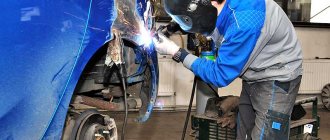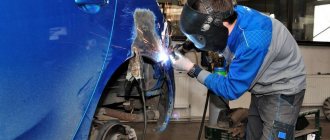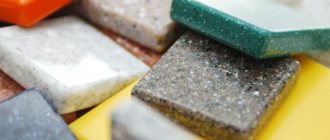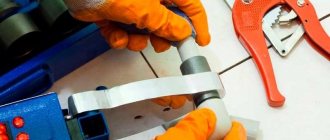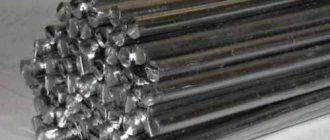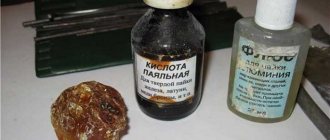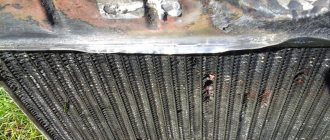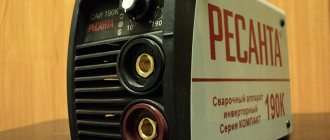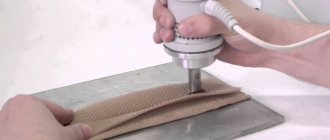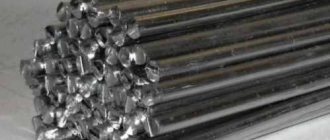Repair work that involves straightening the car body is rarely done without special operations related to tinning metal parts. Soldering a body with tin is a common procedure that requires skillful use of the technique of working with a soldering tool. During this process, molten solder is first applied to the parts to be joined and then, due to diffusion, fused with the metal of the workpiece.
After hardening, reliable contact between the sheet body elements is established. One of the specific features of tinning operations is that the melting temperature of the solder is noticeably lower than the same indicator for the metals being joined.
How current is the tinning procedure?
No car is immune from rust on its spare parts and main parts, as well as from scratches, cracks and other unpleasant moments.
Faced with such a common problem, car owners begin to wonder whether there is any alternative to expensive replacements of car components. The answer is simple: today a service such as tinning body repair is gaining popularity. This is a fairly relevant procedure, as it helps to significantly save money that could have been spent on major repairs with replacement parts. The advantages of this repair method include:
- long service life;
- no shrinkage even when applying a thick layer;
- high level of elasticity and strength, in comparison with putty;
- does not peel off or crack;
- waterproof;
- withstand high temperatures.
It is worth noting that most often this type of repair is used when repairing complex dents on the body. In this case, experts use tinning of the body with tin, since with its help it is possible to perfectly level the surface in order to subsequently apply a thin layer of putty material.
Abrasive material for car body processing
We can use special tin files (body), scraper, chisel and 80 sandpaper to smooth the surface and remove excess tin layer.
Tinning paste contains an acid that is released when heated and is not very beneficial to health if the fumes are inhaled, as well as if dust is inhaled when grinding solder containing poisonous lead. Protective equipment – gloves and respirator.
DAEWOO ⇒ Tinning is the beginning of the fight against early rust
Moderator: alex_aka
Post by Vladimir-alliance » March 31, 2013, 19:32
Upon closer inspection (in good sunlight) the body of the bedik revealed several places of early rust - these are a couple of spots in the cabin - near the pedals and along the top of the cabin - gutters and door cuts. Immediately a question for comrades who have experience in this fight: how to remove, clean up and neutralize. I’ll say right away that I don’t believe in orthophosphorus. rust will then begin to creep under it again... there is a desire to tin it, but without treating it with acid... some kind of grease like lard for soldering. I want to tin all the initial spots and then paint over them. what advice would you give?
Added after 14 minutes 59 seconds: I looked at how the damas rusted from the inside and wanted to keep my suzi badik for another 20 years!
Message by alex73. » March 31, 2013, 20:57
Post by Vladimir-alliance » March 31, 2013, 21:36
Alex73., thanks, I’ll try.. it means I was thinking in the right direction. Previously, cars had tinned bodies.. Pobeda, gas 21. They served for a very long time.. and the gas tanks were also tinned.
Instructions for sealing a hole in the bottom of a car without welding
Product Description
Wurth Sabesto tin soldering paste is lead-free, with a tin content of up to 70%. It has low viscosity and excellent capillary properties. Completely ready for use - does not require mixing or any additional manipulations before soldering.
The composition is easy and simple to apply, does not stick to the spatula, and is well leveled. Provides uniform tinning, creates a smooth layer without roughness. Melts at an operating temperature of +230…+250оС.
After tinning, it also does not require additional manipulations, surface leveling, etc. Flux residues are easily removed with a soft material or brush, leaving a smooth and beautiful surface.
The type of flux complies with DIN EN 29454–1. The product is distributed in tin cans weighing 1 kg.
Materials for tinning car body
Tinning, due to skill and material requirements, is a relatively expensive business, but at the same time is perfectly compatible with modern technologies.
Soft solder - tin tin plating compounds contain only 25-30% tin, the rest lead. Tin solders for heaters, electricians or plumbers are too hard and therefore not suitable.
They don't work well even on horizontal surfaces. We can recognize the hardness of the solder by the fact that the bar is soft when bent. If we hear a crackling sound, the solder is hard and therefore not good.
The heat source can be an autogenous, flash lamp or propane-butane burner with a narrow flame or a hair dryer with a power of more than 2000 W.
The tin spatula must be made of wood (beech, oak or bamboo). The shape of the spatula is determined by the purpose of its use.
- For rough grinding, use a wide straight spatula, the shape of which matches the radius of the spatula.
- Use thin spatulas to smooth a very wide trowel level or an iron-on trowel for finer smoothing.
- Precise and perfect application of solder to the surface in the most optimal layer will save you from the subsequent work of grinding off the excess layer of tin.
- If necessary, you can buy trowels, but making your own will be cheaper.
Means for impregnating screeds. To prevent the tin from sticking to the trowel during operation, it is necessary to treat it with a substance that prevents the tin from sticking to the wood.
The purchased trowels have already been processed, but the processing must be repeated. You can use any oil except transmission oil (it smells), paraffin works well, but raw beeswax is best.
General information about the technology
To obtain a high-quality connection of body parts, you must perform the following steps:
- first, all body parts are carefully prepared for repair;
- then the surfaces intended for soldering are treated with flux;
- after this, you should tin them well (for this purpose, a special paste for tinning the body is used);
- These works are completed by soldering automotive parts.
To reliably connect metal workpieces by soldering, solder is used, which in addition to the main component must contain lead.
The use of pure tin alone is unacceptable, since it does not provide the required melt fluidity, and, therefore, does not allow obtaining a high-quality joint. Let's add to this that when tinning a car body without a special admixture, after the metal cools, the solder becomes brittle.
To avoid this, a lot of lead is added to it even before soldering begins. In proportion it looks like this: 33 percent tin, and the rest is lead.
This type of solder is not intended for soldering car parts made of aluminum and its alloys. To work with these metals, special lead-tin rods must be used, as well as special tinning powder. The melting point of such tin solders does not exceed 230-250 degrees.
- How to properly wash a car engine with your own hands
Methods for tinning a car body
Repair work that involves straightening the car body is rarely done without special operations related to tinning metal parts.
Soldering a body with tin is a common procedure that requires skillful use of the technique of working with a soldering tool.
During this process, molten solder is first applied to the parts to be joined and then, due to diffusion, fused with the metal of the workpiece.
After hardening, reliable contact between the sheet body elements is established. One of the specific features of tinning operations is that the melting temperature of the solder is noticeably lower than the same indicator for the metals being joined.
General information about the technology
To obtain a high-quality connection of body parts, you must perform the following steps:
- first, all body parts are carefully prepared for repair;
- then the surfaces intended for soldering are treated with flux;
- after this, you should tin them well (for this purpose, a special paste for tinning the body is used);
- These works are completed by soldering automotive parts.
To reliably connect metal workpieces by soldering, solder is used, which in addition to the main component must contain lead.
The use of pure tin alone is unacceptable, since it does not provide the required melt fluidity, and, therefore, does not allow obtaining a high-quality joint. Let's add to this that when tinning a car body without a special admixture, after the metal cools, the solder becomes brittle.
To avoid this, a lot of lead is added to it even before soldering begins. In proportion it looks like this: 33 percent tin, and the rest is lead.
This type of solder is not intended for soldering car parts made of aluminum and its alloys. To work with these metals, special lead-tin rods must be used, as well as special tinning powder. The melting point of such tin solders does not exceed 230-250 degrees.
Removing paint
Preparatory work before tinning is carried out in order to clean the surface of metal workpieces from traces left after painting body elements. To do this, you can use a drill equipped with a cleaning attachment in the form of a “brush” with metal bristles.
For small amounts of work, it is more convenient to use large sandpaper. Upon completion of paint removal, you need to wipe off any remaining dust and microparticles from the surface with a clean flannel soaked in solvent.
Final cleanup
Before soldering, unpainted body elements (including its bottom) should be cleaned of oil stains, dirt and foreign deposits. To do this, it is most convenient to use a metal brush, first removing the rust with a file.
Sometimes a special glass sandpaper is used to remove paint, which should be handled very carefully, avoiding the formation of sediment. To remove stains and traces of greasy stains found on parts, you can use the same soft flannel soaked in solvent.
If you use sandblasting, the body will be ideally prepared for tinning, but this procedure requires special equipment.
Flux treatment
The need for pre-treatment with a flux composition is explained by the desire to prevent oxidation of surfaces before and during the work. Zinc chloride, as well as its derivatives with the addition of rosin and stearin, can be used as a flux.
In the process of coating sheet blanks, it is necessary to carefully ensure that there are no “gaps” or places not covered by the flux composition. Otherwise, it will be very difficult to tin and solder them.
Since zinc chloride is a chemically active product, only glass containers should be used for its storage. After finishing the body treatment, the surface must be thoroughly wiped to remove any remaining reagent and eliminate the possibility of metal oxidation.
Using a special paste for tinning, which contains flux and solder, will speed up the work. After applying it, the surface of the body just needs to be heated with a gas burner, and it will be ready for soldering.
Tinning with a soldering iron
Tinning the body or any other part of the car (car radiator, for example) allows you to prepare them for subsequent soldering and greatly facilitates it. These jobs are relatively easy to perform and can be done independently.
To carry them out you will need the following consumables and tools:
- source of open fire (blowtorch, burner);
- special soldering device (hammer soldering iron);
- solder, flux and rosin.
Below we describe the general procedure for carrying out work, when tinning is supposed to be done using a soldering iron heated over an open fire.
First, a piece of solder is brought to the hot tip and held until it begins to flow into the work area. In this case, the surface being treated is wetted, to facilitate which the soldering iron gradually moves along the sheet. As a result of this operation, a thin layer of lead-tin composition is formed on the part.
During tinning with an open fire, the solder bar is periodically moistened with flux or special tinning powder.
Simultaneously with the application of the latter, the well-heated surface is thoroughly wiped with a rag, which ensures better distribution of the flux composition. Upon contact with it, the solder melts, uniformly wetting the metal structure.
Soldering order
Upon completion of the tinning procedure, you can move on to the next stage of work - soldering the car body, which can be organized in two ways: using an open flame torch or using a powerful electric soldering iron.
Before starting the soldering procedures, the body elements are generously moistened with flux and then overlapped slightly over each other (butt soldering in this case is unacceptable). After this, the sheets are fixed with special clamps that do not disturb the temperature regime in the soldering zone, and are heated with a well-hot hammer-type soldering iron.
Then a bar of solder is brought to the joining seam, which, in molten form, evenly fills the voids between the sheet blanks, and after cooling, securely fixes them.
The procedure for working with a powerful electric soldering iron is similar to that described above (except that instead of an open flame, an electrical network is used).
Expert recommendations
Before starting work on tinning and soldering the body, it is advisable to familiarize yourself with the following recommendations from professionals:
- When soldering a car body, the soldering iron should not be heated to high heat, as this may cause some of the tin to evaporate. As a result of overheating, the copper contained in the workpieces oxidizes, and the quality of soldering decreases;
- To heat the soldering tool, it is most convenient to use a gas burner;
- during the heating process, the soldering iron tip must be continuously wetted in the solder;
- Before you start soldering, you need to tin all the prepared parts of the car, regardless of the form in which they are presented (as sheet blanks or individual structural elements).
In conclusion, we note that during repair work, the components necessary for tinning and soldering should always be at hand (this applies to both solder and flux, and other consumables).
DIY patch on a fiberglass car body
The first option we proposed is the use of fiberglass. Indeed, this material is already often and successfully used by car enthusiasts. There are many advantages to this, including the versatility of making molds, corrosion resistance, ease of operation, and relative cheapness. Epoxy resin is used to fix the fiberglass and form the molds. And now about the same thing, but with a particular example. The installation site for the future patch is cleaned of rust and dirt.
Next, we apply a layer of epoxy resin and apply fiberglass impregnated with it.
As a result, after drying, we apply several more layers of fiberglass impregnated with epoxy. As we said, this method is quite accessible to car enthusiasts, but it is not without its drawbacks. Firstly, this is not high enough adhesion, which means that your patch is more likely to come off. Secondly, there are excessively different temperature expansions of metal and fiberglass, which again affects the strength of the connection of these materials to each other. This method is more suitable for plastic parts and the like. In any case, if you do not have any special alternatives, this option is quite acceptable. Unless epoxy and fiberglass, after hardening, are best impregnated with bitumen or something similar, that is, painted.
Soldering order
Upon completion of the tinning procedure, you can move on to the next stage of work - soldering the car body, which can be organized in two ways: using an open flame torch or using a powerful electric soldering iron.
Before starting the soldering procedures, the body elements are generously moistened with flux and then overlapped slightly over each other (butt soldering in this case is unacceptable). After this, the sheets are fixed with special clamps that do not disturb the temperature regime in the soldering zone, and are heated with a well-hot hammer-type soldering iron.
Then a bar of solder is brought to the joining seam, which, in molten form, evenly fills the voids between the sheet blanks, and after cooling, securely fixes them.
Methods for unscrewing bolts, screws or screws with licked heads
The procedure for working with a powerful electric soldering iron is similar to that described above (except that instead of an open flame, an electrical network is used).
Smoothing and sanding
After the solder is spread over the working surface, you need to start tinning and smoothing. We will use a spatula called a flat iron.
We heat the tin only on the surface and use the iron to create an absolutely smooth surface. At the same time, we can remove excess solder so we don't have to sand as much.
- We perform cold grinding. For rough work, it is best to use an angle grinder with a suction cup.
- If we did not apply too much tin, then we will be content with a file; we will finish the finer cleaning with sandpaper.
It can be on the brush (flat surfaces) or in the hand (curves). After grinding, the surface to be repaired should be smooth, without a tactile transition between the steel of the body and the tin-plated part.
Helpful Tips:
- Tinning very small irregularities down to 0.5mm is ineffective and the use of a sealant may be more appropriate;
- When heating large areas, care must be taken not to create a wave on the sheet metal and not to deform the housing;
- Pay close attention to cables, coverings and pads that are around or on the other side of the sheet being processed to ensure that they do not catch fire or are otherwise damaged by heat. If possible, it is better to remove the part of the body that you are tinning;
- The success of working with tin lies in the ability to select the correct heating temperature for a certain stage of work. Unfortunately, it is impossible to describe and you will only acquire this skill through practice.
Tearing off the covers, revealing secrets...
Undoubtedly, working with polyester putties when preparing the body for painting is a pleasure. There is nothing complicated - apply it, wait a little, cut off the excess material - and you're done! But few people think about what will happen to the surface after complete polymerization of the resin. Imagine a chocolate bar wrapped in foil warmed up in your pocket. What happens if you bend it? The chocolate will bend, but the foil will tear. Approximately the same picture awaits the car owner in a couple of years. It's all about the material compatibility factor that needs to be taken into account. The two materials used must be suitable for each other, and their possible vibrations, bending and deformation must be taken into account. For a visual comparison, you can take two iron rods, cover one with solder, and the second with putty. Try bending them. The result is obvious, but it clearly demonstrates the advantage of using tinning rather than putty in restoration. Of course, fanaticism in this matter is also not beneficial; removing all the planes and roughness with solder will be expensive, but in small quantities this method will be completely justified.
Product Description
Wurth anti-gravel underbody protection is a special rubber and solvent based composition that is applied to the lower vulnerable parts of the vehicle using a spray. There are Wurth anti-gravel black and gray. Both of them are suitable for subsequent priming of the product with painting. Moreover, it can be painted with any standard one- and two-component paints made on the basis of solvents or water.
The composition has excellent adhesive properties, quickly and reliably adheres to the surface, and quickly forms a durable and elastic shockproof coating. The composition also dries quite quickly: applied in several layers, it is ready for further processing (priming and painting) after only a day.
The coating formed by the composition is designed to reliably protect the lower part of the car from impacts from gravel and stones, from the formation of scratches, reduce noise and vibration, prevent water from penetrating and prevent rust and corrosion.
Types of solders for body repair
- There are different types of solders. For body repairs, soft (low-melting) solders are often used. They are sold in the form of rods, 45 cm long, of different thicknesses. In general, they are classified as lead free or lead free solders. The first type of solder was used for many years due to its ease of use. However, it has been banned in some countries for use in mass production due to health and environmental concerns. However, lead solder is still used by individuals and can be found commercially. Many craftsmen prefer to use lead solder.
- The ratio of its components (tin, lead) is indicated on the solder. Traditional body solder is 30% tin and 70% lead. May contain an additional component, for example, 74% lead, 25% tin and 1% antimony. Lead is hazardous to health. To use it, protective equipment is required and safety precautions must be taken into account. However, it is easier to use. It remains soft longer after heating (in the range of 180 to 260 degrees Celsius). This makes it easier to apply and level. This solder is easily applied to vertical and horizontal surfaces. Once lead solder has hardened, it is not recommended to process it with a grinder, as very toxic dust is generated. So, it is usually processed with a special body file, and at the final stage with a block of coarse sanding paper by hand. If you still use a grinding machine, then you need to use only coarse abrasive so that there is no suspension of fine dust. Lead residues after grinding must be disposed of immediately.
Solder containing lead (Pb 74%), tin (Sn 25%) and antimony (1%).
- Solder can have different lead to tin ratios (70/30, 60/40 or 50/50). Solder with lower lead content is also used in auto body repairs, but has a low ductility range (183ºC to 188ºC) so it is more difficult to use. Solders with this ratio are usually used on horizontal surfaces, since they quickly become liquid and can flow. The adhesion of all lead solders is approximately the same and depends on proper surface preparation.
- As an alternative to lead solder, safer lead-free solder has been developed. In all lead-free solders, tin is the main component. The other component may be silver, copper, indium or bismuth. Most lead-free solders have either a higher or lower melting point than lead solder. For body repairs, the most common lead-free solder is a mixture of tin and silver (94% tin and 6% silver or 96% tin and 4% silver). It has a higher cost. Lead-free solder is approximately equal in performance to traditional lead solder with a 50/50 (lead/tin) ratio. This solder has a higher melting point (221°C). Once heated, it remains soft for less time than lead solder, making it more difficult to align. When hardened, it becomes harder and more brittle. It is more difficult to process with a file. The advantage is that it can be sanded as it does not produce toxic dust. Although, do not forget about the respirator. An additional benefit of lead-free solder is higher tensile strength.
- Solder used in electronics typically consists of 60% tin and 40% lead. It may contain flux in the center. Rosin flux, often used with this solder, does not promote adhesion to steel, but acid flux may work well. This solder is best used only for soldering small holes, since its ductility range is very small.
- To work with aluminum bodies, a different type of solder (containing tin and zinc) is used.
What is flux? What flux should I use for tinning the body?
The purpose of the flux is to facilitate the soldering process and ensure the strength of the connection between the solder and the metal of the body. One of the barriers to achieving successful soldering is surface impurity (contamination and oxidation). Contaminants can be removed by mechanical cleaning, but oxidation increases with increasing temperature, impairing solder adhesion to the repair surface. The metal has a thin layer of oxides or sulfides, no matter how clean it appears. The purpose of the flux is to remove this layer and should prevent the formation of a new oxide layer during solder application. Flux not only prevents oxidation, but also provides dry cleaning and performs a wetting function by reducing the surface tension of the molten solder, helping it flow better over the surface. This way, the solder will not stick to an unprepared metal surface; it will form balls. On the prepared surface, the solder spreads and sticks normally.
Flux paste for tinning.
Flux paste is used for tinning the body. It is a kind of primary soil. It contains acid (zinc chloride or hydrochloric acid) and solder in powder form. The acid chemically cleans the surface and removes oxidation, converting it into a soluble salt, while the powder simultaneously eats into the metal, leaving a very thin layer (tin or tin with lead) that improves solder adhesion when applied to the repair area.
After application, the paste needs to be heated and the residue wiped off with a rag.
The flux paste is activated by an acid (zinc chloride or hydrochloric acid) and must be removed after soldering is completed. If the flux is based on hydrochloric acid, then it can be neutralized with water and soda, and then washed with clean water. If the flux contains zinc chloride, then acetone will be required for neutralization. You can also use sodium dichromate.
Particles from the flux paste can remain in the pores and small cavities of the weld, which can cause corrosion. Therefore, before tinning and applying solder, it is necessary that the holes and recesses be welded.
Product Description
Wurth anti-corrosion coating is made on the basis of bitumen-rubber resin. It is a black liquid with a characteristic odor. It has excellent technical characteristics, including thermal stability over a wide range and water resistance.
Forms a film on the surface of parts that reliably protects them from rust and corrosion, from impacts, from exposure to water (including salt water), weak acids and alkalis. Excellent noise absorption.
The film does not shrink after the composition has completely dried. Created for a long time: even with regular adverse environmental influences, it protects the underbody of the car, wheel arches and other vulnerable areas.
Soldering a car body (step by step)
Modern case soldering is technologically not particularly different from the tinning process, but in most cases other materials are used.
- It is typically a two-part epoxy resin-based cold repair material that was developed as a replacement for conventional tin soldering in auto body damage repairs.
- In addition to faster cure, easier sanding and easier application, the solder material also eliminates the need for hot and open flame processes otherwise required with tin tin plating.
As the automotive industry continues to develop new body materials, there is a growing need for compatible repair technology that does not affect adjacent plastic or noise components, paint or corrosion protection.
Epoxy resin compounds can be applied at room temperature without the use of flame or solder.
- Soldering materials are supplied in hand gun cartridges along with a special mixing attachment for easy application.
- Can be used on all metal surfaces, including modern steel alloys and aluminum, for body repair of all types of vehicles, including trucks.
- Unlike tin soldering and open flame, high temperatures and open flames are not used, which means that repaired parts of the case do not need to be disassembled and reassembled, which saves time and prevents possible damage to adjacent parts of the case.
Due to their properties, such soldering materials are also ideal for repairs in hard-to-reach places. The cold process ensures that the varnish and protective anti-corrosion coating near the repaired area will not be damaged.
The soldering time for the material is approximately 10 minutes (depending on ambient temperature), which is enough time for the repaired part to return to its original shape.
In addition, modern solder materials are easier to apply and sand than previous epoxy-free options. The result is a smooth base for subsequent puttying and painting.
Soldering technology is practically no different from tinning technology, but requires less labor and does not contain dangerous lead in the solder.
Purpose and benefits
Tinning of metal with tin is used in the following industries:
- Electronics and radio engineering. Tin protects circuit boards from corrosion.
- Aviation and mechanical engineering. Many structural elements of machine tools and aircraft are processed.
- Cable and wire. In addition to rubber insulation, tin protects metal conductors from the effects of sulfur, which is contained in rubber and plastic.
- Food. Almost all kitchen utensils related to cooking are protected using special food-grade tin, which does not pose a threat to human health. Also, containers intended for making canned food are coated with tin: this increases their shelf life - many conscripts remember Soviet stewed meat from the fifties, which until recently was in military warehouses as an emergency reserve.
However, tinning technology has gained the greatest popularity as a means of preliminary preparation before soldering. This is due to the following reasons:
- Performance. Modern technologies make it possible to tinning a large number of elements in a short period of time - it is not without reason that it is actively used in mass production.
- Reliability. The chemical inertness of tin provides reliable protection against moisture, salts and organic acids.
- Durability of the coating. Tin and its alloys have high adhesion to any metal surface. The plastic layer is not destroyed by mechanical processing of the part.
- Heat resistance. Tinned coating can withstand significant temperature changes.
Three technologies
There are three technologies for soldering iron with tin:
- soldering iron To do this, you will have to use soft solders with a high lead content;
- blowtorch. This will require hard solders with a high tin content;
- electrical soldering of iron.
The first method is used if the iron will not be subjected to heavy loads during operation. The second is tinning of iron with tin, when tin solder is applied to the surface of a metal product and rubbed over its entire plane in a thin layer.
This technology requires soldering flux. The third option is used on a production scale, for which special equipment is used.
Solder Application
We take a tin rod, apply it to the repair site (cavity), heat it slowly and apply molten tin to the body with light pressure. The amount of tin applied depends on the size of the dent on the body.
For beginners, it is advisable to position the body so that the working area is in a horizontal or slightly inclined position so that the tin does not drain.
- We need to give the tin cake that we applied to the surface the desired shape.
- We begin to slowly but smoothly heat the applied tin.
- By lightly pressing the spatula, we find out the depth of heating; the lead should be heated to depth, and not just melt on the surface.
- We should have the consistency of softened butter.
- With this consistency we can spread. If we overheat the lead, it will drain.
Attention! If you put tin solder on a cold part of the case, it will stick and cause problems when sanding.
Advantages and disadvantages
Here are the advantages of Wurth tin paste:
- high percentage of tin content (60-70%);
- low heating temperature required for operation;
- uniformity and ease of distribution during tinning;
- leveling the surface of the material during soldering;
- no need for additional manipulations or mixing - the paste is ready for tinning;
- long shelf life without tin peeling;
- low viscosity and good capillary properties;
- excellent wetting.
Reviews about this product are excellent, which shows compliance with all technical characteristics declared by the manufacturer and the absence of shortcomings.
Sealing holes
- Welding holes entails thermal deformation (the metal thickens and contracts), which may require subsequent straightening. Sealing with reinforced putty will only give temporary results. Solder can fill the hole and serve as a good alternative to welding.
- When soldering a large hole, you can recess the metal around it a little so that the solder fills it with a margin and sticks not only to the edges of the hole. You can also drill a hole with a countersink drill for metal of the required size, or process the edge of the hole with a round file so that it is located obliquely. This will help the solder stick to the edge better.
- Also, when filling a large hole, you can stick aluminum tape on the back side, which will serve as a base for solder. To ensure that the adhesive composition of the tape does not affect the quality of the repair, you need to cut out a segment from the same tape, slightly larger than the hole, and stick it on the tape (shiny side out), which will be glued to the back side of the hole. For convenience, you can mark the center, which should coincide with the hole. This will create double shiny tape. Next you need to stick this entire applique on the back side of the hole. In order not to overheat the metal, you can tin the metal around the hole and its edge with a soldering iron, and also melt the solder with a soldering iron.
- In a similar way, you can repair through holes from rust if the metal around them is strong. It is necessary to pre-treat the rusty edges of the hole and slightly recess the metal around it.
- Small holes can be filled with solder, which is used for soldering electronics.
- When sealing holes with solder, flux residues on the back of the panel can cause accelerated corrosion of the metal. Therefore, it is better to remove flux residues with hot water and soda on both the front and back sides.
What tools and materials are needed for tinning and soldering the body?
- There are special kits that include the solder itself, flux paste, tools for leveling the applied solder and instructions. Also, all accessories can be purchased separately.
Set for tinning and soldering the body.
- Requires solder and tinning paste with a brush for easier application.
- You also need a clean rag (cotton is best) to wipe off any remaining paste after heating.
- For heating, you need a welding gas torch, propane (butane) torch or hair dryer with adjustable temperature and air flow. When using a gas welding torch, the flame must be set to the minimum temperature at which the flux will melt and the body metal will heat up.
- The solder is leveled using special hardwood blocks. A special lubricant (solid animal fat), a thin layer of oil or beeswax is applied to the paddle or block so that it does not stick to the solder. So the solder, smoothed out in blocks, turns out more even. You can make a block of the desired shape yourself.
- You must use a HEPA (high efficiency particulate air) respirator with a high efficiency particulate air filter, also known as an N100 filter. You can also install a fan nearby, which will blow harmful fumes away from the master. Then the harm of fumes is reduced and you can do without a respirator. Gloves must be used when using lead solder. Avoid contact of solder and flux with skin.
- To handle hardened solder, you will need a body file or a sanding block with coarse sandpaper.
- It is necessary that all materials and tools are within reach so as not to waste time during tinning.
How to solder without a soldering iron and how you can replace it
Do-it-yourself tinning of boards in glycerin. The method of hot tinning a printed circuit board in glycerin allows you to cover copper with a thin and uniform layer of solder. The technology of applying the ROSE alloy is familiar to many radio amateurs, but it has several disadvantages: ROSE is a brittle alloy, the soldering points for mounting components are covered with oxides and turn black, this negatively affects the quality of the product, ROSE also lowers the melting point of the solder, which can play a bad joke when installing components dissipating a decent amount of heat is only useful when dismantling components. There is a way out - replace the ROSE alloy with solder paste, and the water with glycerin! Necessary tools, equipment and chemistry photo below:.
Final cleanup
Before soldering, unpainted body elements (including its bottom) should be cleaned of oil stains, dirt and foreign deposits. To do this, it is most convenient to use a metal brush, first removing the rust with a file.
Sometimes a special glass sandpaper is used to remove paint, which should be handled very carefully, avoiding the formation of sediment. To remove stains and traces of greasy stains found on parts, you can use the same soft flannel soaked in solvent
If you use sandblasting, the body will be ideally prepared for tinning, but this procedure requires special equipment.
Advantages and disadvantages
Anticoror Wurth has the following advantages:
- fast action and long-lasting effect;
- increased abrasion resistance and protection against gravel impacts;
- reduction of noise when driving a car (additional sound insulation);
- formation of a thick protective film;
- no shrinkage of the surface after complete drying (according to DIN 53152);
- low content of harmful substances in the composition, environmental friendliness;
- resistance to water, including salt water, weak acids and alkalis;
- thermal stability over a wide range.
Among the disadvantages, judging by consumer reviews, is the high price of the product. There are no complaints about the quality.
Expert recommendations
Before starting work on tinning and soldering the body, it is advisable to familiarize yourself with the following recommendations from professionals:
- When soldering a car body, the soldering iron should not be heated to high heat, as this may cause some of the tin to evaporate. As a result of overheating, the copper contained in the workpieces oxidizes, and the quality of soldering decreases;
- To heat the soldering tool, it is most convenient to use a gas burner;
- during the heating process, the soldering iron tip must be continuously wetted in the solder;
- Before you start soldering, you need to tin all the prepared parts of the car, regardless of the form in which they are presented (as sheet blanks or individual structural elements).
In conclusion, we note that during repair work, the components necessary for tinning and soldering should always be at hand (this applies to both solder and flux, and other consumables).
Flux treatment
The need for pre-treatment with a flux composition is explained by the desire to prevent oxidation of surfaces before and during the work. Zinc chloride, as well as its derivatives with the addition of rosin and stearin, can be used as a flux.
In the process of coating sheet blanks, it is necessary to carefully ensure that there are no “gaps” or places not covered by the flux composition. Otherwise, it will be very difficult to tin and solder them.
Since zinc chloride is a chemically active product, only glass containers should be used for its storage. After finishing the body treatment, the surface must be thoroughly wiped to remove any remaining reagent and eliminate the possibility of metal oxidation.
Using a special paste for tinning, which contains flux and solder, will speed up the work. After applying it, the surface of the body just needs to be heated with a gas burner, and it will be ready for soldering.
Specifications
| Name | Meaning and units |
| Chemical basis | bitumens |
| Foundation preparation required | dry surface, free from dust and grease |
| Smell/aroma | characteristic |
| Color | black |
| Proportion of solids content | min. 66% |
| Complete drying conditions | at 20 °C, wet layer 400 µm |
| Spray distance | min. 20 cm |
| Surface film formation time, conditions | at 20 °C |
| Skin formation time | min. 75 min |
| Drying time | 2.5 h |
| Drying time, conditions | at 20 °C |
| Density | 1.09 kg/m³ |
| Flash point | 200 °C |
| Thickness, conditions | at 20°C |
| Shelf life from date of manufacture | 24 months |
| Heat resistance | -25 °C…80 °C |
| Temperature range of application | min. -25 °C |
| Spray distance | Max. 30 cm |
| Overcoatable/re-varnishable | No |
Packaging 1 liter
Tinning and soldering
- Burner or other source of fire.
- Soldering iron.
- Consumables.
Consumables for performing the work are flux, solder and rosin. Tinning with a soldering iron is performed by melting the solder with the hot tip of the tool. Due to the physical properties of tin, this does not require intensive processing. Under the influence of temperature, the solder becomes liquid, flowing onto the work surface, forming a solder bath. The distribution of the working composition is regulated by the movement of the soldering iron.
After using the entire composition, wipe the working surface with a rag. This must be done immediately while the surface is still hot. This procedure will help to distribute the composition evenly.
Tinning with a soldering iron
Tinning the body or any other part of the car (car radiator, for example) allows you to prepare them for subsequent soldering and greatly facilitates it. These jobs are relatively easy to perform and can be done independently.
To carry them out you will need the following consumables and tools:
- source of open fire (blowtorch, burner);
- special soldering device (hammer soldering iron);
- solder, flux and rosin.
Below we describe the general procedure for carrying out work, when tinning is supposed to be done using a soldering iron heated over an open fire.
First, a piece of solder is brought to the hot tip and held until it begins to flow into the work area. In this case, the surface being treated is wetted, to facilitate which the soldering iron gradually moves along the sheet. As a result of this operation, a thin layer of lead-tin composition is formed on the part.
During tinning with an open fire, the solder bar is periodically moistened with flux or special tinning powder.
Simultaneously with the application of the latter, the well-heated surface is thoroughly wiped with a rag, which ensures better distribution of the flux composition. Upon contact with it, the solder melts, uniformly wetting the metal structure.
